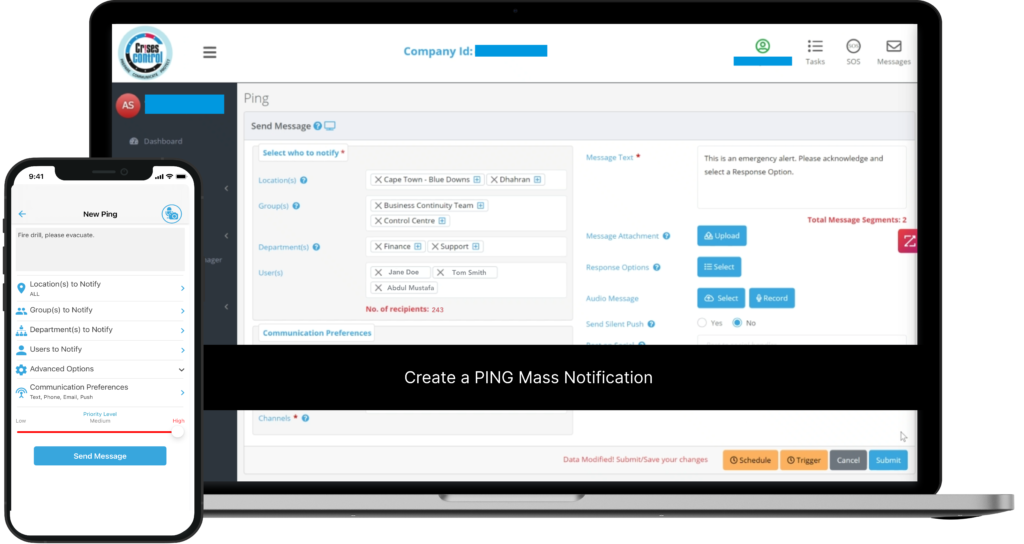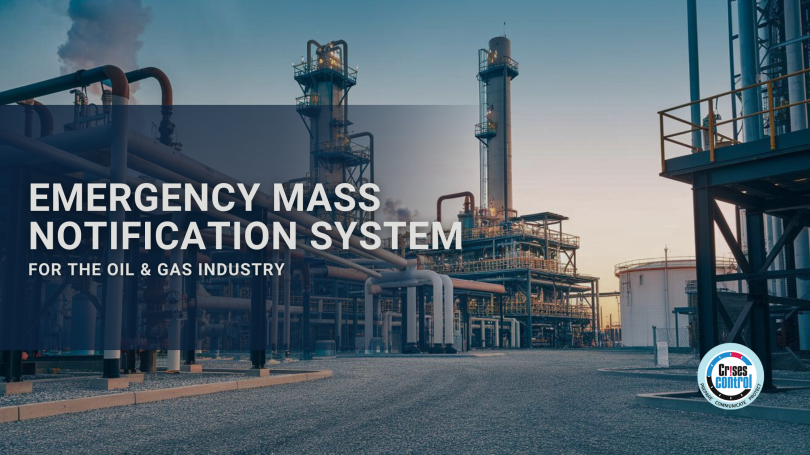Written by Anneri Fourie | Marketing Executive
In the high-stakes world of oil and gas, even minor incidents can escalate into major disasters. From pipeline leaks and equipment malfunctions to fires and explosions, rapid and effective communication is paramount for ensuring worker safety, mitigating environmental damage, and minimising operational disruptions. This is where Emergency Mass Notification Systems come into play.
Emergency Mass Notification Systems are powerful tools that enable companies to instantly broadcast critical alerts and instructions to a targeted audience, ensuring everyone on-site or within a designated area is aware of the situation and can take appropriate action. However, the specific needs of the oil and gas industry necessitate a robust and feature-rich Emergency Mass Notification System solution. Let’s delve deeper into how an Emergency Mass Notification System, specifically Crises Control, can enhance safety protocols in this demanding environment.
The Challenges of Emergency Communication in Oil & Gas Operations
Oil and gas facilities often encompass vast areas, including remote locations, offshore platforms, and complex processing plants. This inherent geographical spread presents significant challenges for effective communication, especially during emergencies. Here are some key hurdles to overcome:
- Time Sensitivity: Every second counts during an emergency. Traditional communication methods, like phone calls or public address systems, can be slow and cumbersome, leading to critical delays in response.
- Targeted Communication: Not all personnel need the same information during an emergency. An Emergency Mass Notification System allows for targeted messaging based on location, role, or work area, ensuring that relevant personnel receive the most critical instructions.
- Noise and Hazardous Environments: Oil and gas facilities can be noisy and hazardous, making it difficult to hear or understand traditional communication methods. Emergency Mass Notification Systems can deliver alerts through various channels, including text messages, emails, and desktop notifications, bypassing these limitations.
- Remote Workforces: The oil and gas industry increasingly utilises remote workforces. Emergency Mass Notification Systems can reach dispersed employees, ensuring they are informed and can contribute to the emergency response effort.
- Integration with Existing Systems: For seamless operation, an Emergency Mass Notification System should integrate seamlessly with existing safety systems, such as fire alarms, allowing for automatic alerts and real-time data exchange.
How Emergency Mass Notification Systems Streamline Communication and Enhance Safety
Emergency Mass Notification Systems (EMNS) can significantly improve emergency response in the oil and gas industry by providing several key benefits:
- Rapid Dissemination of Alerts: EMNS can broadcast critical alerts to a large number of personnel within seconds, ensuring everyone is informed about the situation immediately. This rapid notification allows for faster evacuation, implementation of safety protocols, and containment of incidents.
- Multi-Channel Communication: EMNS utilises various communication channels, such as SMS, voice calls, emails, and desktop pop-ups, ensuring messages reach everyone, regardless of their location or environment. This redundancy ensures critical information is received even if primary communication channels are compromised.
- Targeted Messaging: EMNS allows for targeted messages based on location, role, or work area. This ensures that personnel receive the most relevant instructions and avoid unnecessary confusion or panic. For example, evacuation instructions for onshore personnel can differ from those for offshore rig workers.
- Improved Situational Awareness: EMNS provides real-time updates on the evolving situation, allowing for informed decision-making by emergency responders and management personnel.
- Enhanced Coordination: EMNS facilitates coordinated response efforts between different teams and emergency services, leading to a more efficient and effective overall response.
- Reduced Response Time: Faster notification translates to faster response times, which can be crucial in mitigating the severity of an incident.
- Improved Regulatory Compliance: Many regulatory bodies mandate specific communication protocols during emergencies. EMNS can help companies comply with these regulations by ensuring timely and accurate notification to relevant personnel.
Beyond the Basics: Advanced Features for Oil & Gas Operations
While the core functions of Emergency Mass Notification Systems (EMNS) are essential for emergency response, advanced features can further enhance their effectiveness in the oil and gas industry:
- Geolocation Capabilities: EMNS can leverage GPS or other location-based technologies to automatically identify the location of personnel and send targeted alerts accordingly. This ensures that messages reach the right people at the right time, even in remote or challenging environments.
- Two-Way Communication: Advanced EMNS platforms offer two-way communication capabilities, allowing for real-time interaction between emergency responders and personnel on-site. This enables responders to gather critical information, provide specific instructions, and coordinate response efforts more effectively.
- Integration with Safety Systems: EMNS can be integrated with other safety systems, such as fire alarms, and gas detection systems. This allows for automatic triggering of alerts based on specific events, ensuring a timely and coordinated response.
- Analytics and Reporting: Advanced EMNS platforms offer robust analytics and reporting capabilities, providing valuable insights into emergency response performance. This data can be used to identify areas for improvement, optimise communication protocols, and measure the effectiveness of emergency preparedness plans.
- Scalability and Flexibility: EMNS should be scalable to accommodate the varying needs of different oil and gas operations. Whether you have a small onshore facility or a large offshore platform, the system should be able to handle the required number of users and communication channels.
The Role of Crises Control in Enhancing Oil & Gas Safety
Crises Control is a leading provider of emergency mass notification systems designed to meet the unique needs of the oil and gas industry. Our platform offers a comprehensive suite of features, including:
- Rapid and Reliable Communication: Instantaneous delivery of alerts to a wide range of devices, ensuring everyone is informed in real-time.
- Targeted Messaging: Precisely target messages based on location, role, or work area, ensuring relevant personnel receive the most critical information.
- Two-Way Communication: Enable real-time interaction between emergency responders and personnel on-site for improved coordination and decision-making.
- Integration with Existing Systems: Seamlessly integrate with fire alarms, and other safety systems for automated alerts and streamlined response.
- Advanced Analytics: Gain valuable insights into emergency response performance through detailed analytics and reporting.
- Scalability and Flexibility: Accommodate the varying needs of different oil and gas operations, from small onshore facilities to large offshore platforms.
By partnering with Crises Control, you can enhance safety protocols, improve emergency response times, and protect your workforce and assets.
Interested in our Ping Mass Notification Software?
Efficiently alert everyone in seconds at scale with our Mass Notification System – PING, get the message out fast and ensure rapid response and recovery.

Conclusion
Emergency mass notification systems are indispensable tools for enhancing safety in the oil and gas industry. By streamlining communication, improving situational awareness, and facilitating coordinated response efforts, Emergency Mass Notification Systems can help prevent accidents, mitigate the impact of incidents, and protect the environment.
If you’re looking to invest in a robust and reliable Emergency Mass Notification System solution, Crises Control is your trusted partner. Our platform is designed to meet the unique needs of the oil and gas industry, providing advanced features, exceptional reliability, and unparalleled support.
Don’t wait until it’s too late. Contact us today to schedule a free demo and learn how Crises Control can help you enhance safety and protect your operations.
Request a FREE Demo

FAQs
1. What is an Emergency Mass Notification System (EMNS)?
2. How can Emergency Mass Notification Systems (EMNS) improve safety in the oil and gas industry?
3. What are the key features of an effective Emergency Mass Notification System?
Rapid dissemination of alerts: The system should be able to send messages to a large number of people quickly and reliably.
Targeted messaging: EMNS should allow for targeted messages based on location, role, or work area.
Integration with existing systems: The system should be able to integrate with other safety systems, such as fire alarms.
Analytics and reporting: EMNS should provide analytics and reporting capabilities to help organisations improve their emergency response plans.
